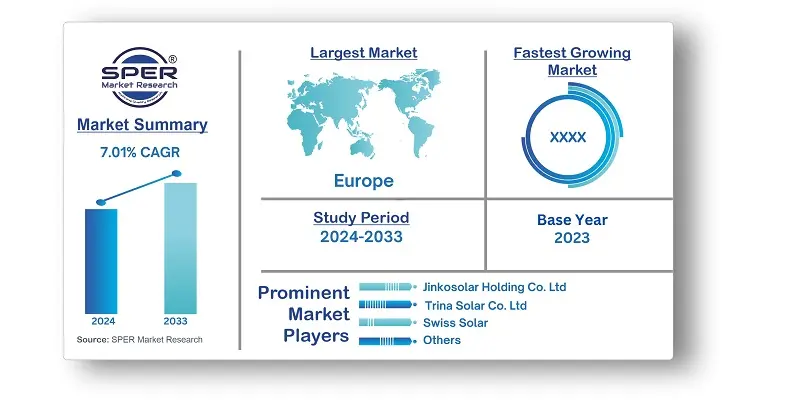
Switzerland Solar Energy Market Trends, Share, Size, Revenue, Demand and Future Outlook
Switzerland Solar Energy Market Growth, Size, Trends Analysis- By Technology, By Solar Module, By End User- Regional Outlook, Competitive Strategies and Segment Forecast to 2033
| Published: Oct-2024 | Report ID: POAE2485 | Pages: 1 - 106 | Formats*: |
| Category : Power & Energy | |||
- June 2024: Manchester City Football Club has signed a multiyear global agreement with JinkoSolar. JinkoSolar is now the club's Official Solar Energy Partner, promoting solar energy and helping the club achieve its carbon net zero goals.
- May 2024: Recurrent Energy, a subsidiary of Canadian Solar Inc. and a global developer and owner of solar and energy storage assets, announced the signing of a significant multi-currency agreement for the building of renewable energy projects in multiple European countries.


| Report Metric | Details |
| Market size available for years | 2020-2033 |
| Base year considered | 2023 |
| Forecast period | 2024-2033 |
| Segments covered | By Technology, By Solar Module, By End Use |
| Regions covered | Zurich, Espace Mittelland, Lake Geneva Region, Northwestern Switzerland, Eastern Switzerland, Central Switzerland, Ticino, Rest of Switzerland. |
| Companies Covered | Jinkosolar Holding Co. Ltd, Trina Solar Co. Ltd, Swiss Solar, Solaronix S.A., Apak Energy Sagl, Soltop Energie AG, Alpiq Holding AG, Axpo Holding AG, Sunage S.A.. |
- Residential Homeowners
- Commercial and Industrial Businesses
- Municipalities and Local Governments
- Utility Companies
- Real Estate Developers
- Investors and Financial Institutions
- Solar Equipment Manufacturers and Suppliers
- Energy Consultants and Installers
- Non- Governmental Organizations (NGOs)
| By Technology: | |
| By Solar Module: | |
| By End Use: |
- Switzerland Solar Energy Market Size (FY’2024-FY’2033)
- Overview of Switzerland Solar Energy Market
- Segmentation of Switzerland Solar Energy Market by Technology (Solar Photovoltaic (PV), Concentrated Solar Power (CSP))
- Segmentation of Switzerland Solar Energy Market by Solar Module (Polycrystalline, Monocrystalline, Amorphous Silicon Cells, Cadmium Telluride, Others)
- Segmentation of Switzerland Solar Energy Market by End Use (Residential, Commercial, Industrial)
- Statistical Snap of Switzerland Solar Energy Market
- Expansion Analysis of Switzerland Solar Energy Market
- Problems and Obstacles in Switzerland Solar Energy Market
- Competitive Landscape Switzerland Solar Energy Market
- Impact of COVID-19 and Demonetization on Switzerland Solar Energy Market
- Details on Current Investment in Switzerland Solar Energy Market
- Competitive Analysis of Switzerland Solar Energy Market
- Prominent Players in the Switzerland Solar Energy Market
- SWOT Analysis of Switzerland Solar Energy Market
- Switzerland Solar Energy Market Future Outlook and Projections (FY’2024-FY’2033)
- Recommendations from Analyst
1.1. Scope of the report1.2. Market segment analysis
2.1. Research data source2.1.1. Secondary Data2.1.2. Primary Data2.1.3. SPER’s internal database2.1.4. Premium insight from KOL’s2.2. Market size estimation2.2.1. Top-down and Bottom-up approach2.3. Data triangulation
4.1. Driver, Restraint, Opportunity and Challenges analysis4.1.1. Drivers4.1.2. Restraints4.1.3. Opportunities4.1.4. Challenges4.2. COVID-19 Impacts of the Switzerland Solar Energy Market
5.1. SWOT Analysis5.1.1. Strengths5.1.2. Weaknesses5.1.3. Opportunities5.1.4. Threats5.2. PESTEL Analysis5.2.1. Political Landscape5.2.2. Economic Landscape5.2.3. Social Landscape5.2.4. Technological Landscape5.2.5. Environmental Landscape5.2.6. Legal Landscape5.3. PORTER’s Five Forces5.3.1. Bargaining power of suppliers5.3.2. Bargaining power of buyers5.3.3. Threat of Substitute5.3.4. Threat of new entrant5.3.5. Competitive rivalry5.4. Heat Map Analysis
6.1. Switzerland Solar Energy Market Manufacturing Base Distribution, Sales Area, Product Type6.2. Mergers & Acquisitions, Partnerships, Product Launch, and Collaboration in Switzerland Solar Energy Market
7.1. Switzerland Solar Energy Market Size, Share and Forecast, By Technology, 2020-20267.2. Switzerland Solar Energy Market Size, Share and Forecast, By Technology, 2027-20337.3. Solar Photovoltaic (PV)7.4. Concentrated Solar Power (CSP)
8.1. Switzerland Solar Energy Market Size, Share and Forecast, By Solar Module, 2020-20268.2. Switzerland Solar Energy Market Size, Share and Forecast, By Solar Module, 2027-20338.3. Polycrystalline8.4. Monocrystalline8.5. Amorphous Silicon Cells8.6. Cadmium Telluride8.7. Others
9.1. Switzerland Solar Energy Market Size, Share and Forecast, By End Use, 2020-20269.2. Switzerland Solar Energy Market Size, Share and Forecast, By End Use, 2027-20339.3. Residential9.4. Commercial9.5. Industrial
10.1. Switzerland Solar Energy Market Forecast Size and Market Share
11.1. Switzerland Solar Energy Market Forecast Size and Market Share By Region (2020-2026)11.2. Switzerland Solar Energy Market Forecast Size and Market Share By Region (2027-2033)11.3. Switzerland11.3.1. Zurich11.3.2. Espace Mittelland11.3.3. Lake Geneva Region11.3.4. Northwestern Switzerland11.3.5. Eastern Switzerland11.3.6. Central Switzerland11.3.7. Ticino11.3.8. Rest of Switzerland
12.1. JINKOSOLAR HOLDING CO. LTD12.1.1. Company details12.1.2. Financial outlook12.1.3. Product summary12.1.4. Recent developments12.2. TRINA SOLAR CO. LTD12.2.1. Company details12.2.2. Financial outlook12.2.3. Product summary12.2.4. Recent developments12.3. SWISS SOLAR12.3.1. Company details12.3.2. Financial outlook12.3.3. Product summary12.3.4. Recent developments12.4. SOLARONIX S.A.12.4.1. Company details12.4.2. Financial outlook12.4.3. Product summary12.4.4. Recent developments12.5. APAK ENERGY SAGL12.5.1. Company details12.5.2. Financial outlook12.5.3. Product summary12.5.4. Recent developments12.6. SOLTOP ENERGIE AG12.6.1. Company details12.6.2. Financial outlook12.6.3. Product summary12.6.4. Recent developments12.7. ALPIQ HOLDING AG12.7.1. Company details12.7.2. Financial outlook12.7.3. Product summary12.7.4. Recent developments12.8. AXPO HOLDING AG12.8.1. Company details12.8.2. Financial outlook12.8.3. Product summary12.8.4. Recent developments12.9. SUNAGE S.A.12.9.1. Company details12.9.2. Financial outlook12.9.3. Product summary12.9.4. Recent developments12.10. Others
SPER Market Research’s methodology uses great emphasis on primary research to ensure that the market intelligence insights are up to date, reliable and accurate. Primary interviews are done with players involved in each phase of a supply chain to analyze the market forecasting. The secondary research method is used to help you fully understand how the future markets and the spending patterns look likes.
The report is based on in-depth qualitative and quantitative analysis of the Product Market. The quantitative analysis involves the application of various projection and sampling techniques. The qualitative analysis involves primary interviews, surveys, and vendor briefings. The data gathered as a result of these processes are validated through experts opinion. Our research methodology entails an ideal mixture of primary and secondary initiatives.



Frequently Asked Questions About This Report
PLACE AN ORDER
Year End Discount
Sample Report
Pre-Purchase Inquiry
NEED CUSTOMIZATION?
Request CustomizationCALL OR EMAIL US
100% Secure Payment






Related Reports
Our Global Clients
Our data-driven insights have influenced the strategy of 200+ reputed companies across the globe.






















